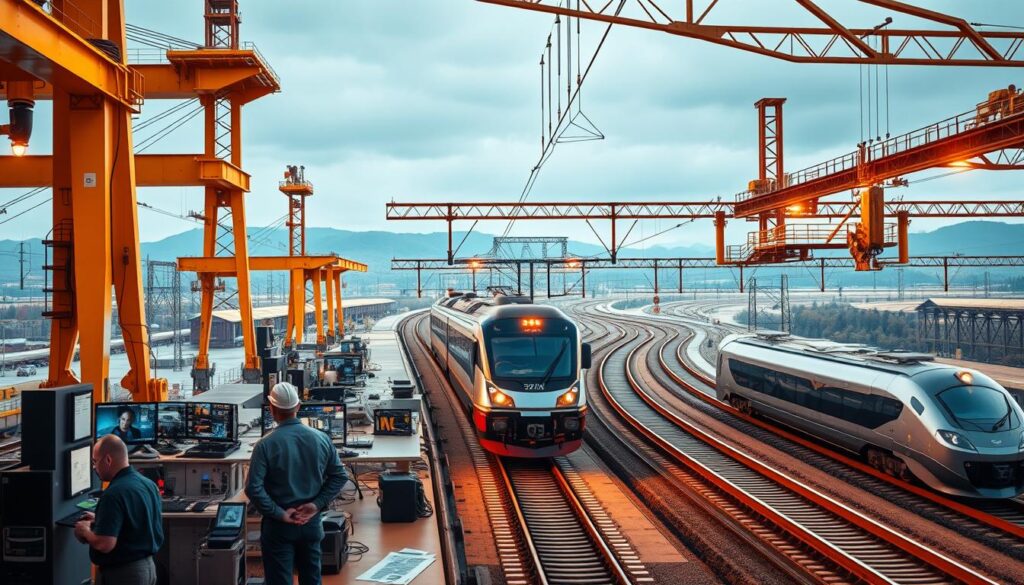Can modern railway systems be transformed to meet the demands of a rapidly changing world? The answer lies in revolutionizing rail infrastructure with cutting-edge engineering expertise.
Innovative solutions and efficient management practices are crucial in transforming the rail sector. By leveraging the latest advancements in railway engineering, it’s possible to create more sustainable, efficient, and safe transportation systems.
The need for expertise in rail infrastructure engineering has never been more pressing. As the world grapples with the challenges of climate change, urbanization, and technological disruption, the rail industry must adapt and evolve.
Key Takeaways
- Expertise in rail infrastructure engineering is crucial for modernizing railway systems.
- Innovative solutions can enhance sustainability and efficiency in the rail sector.
- Efficient management practices are essential for transforming the rail industry.
- Advances in railway engineering can lead to safer transportation systems.
- The rail industry must adapt to the challenges of climate change and urbanization.
Understanding Rail Infrastructure Engineering
Rail infrastructure engineering encompasses the design, construction, and maintenance of rail systems. It is a complex field that requires efficient management and integration of various components to ensure smooth operations.
“The complexity of rail infrastructure demands innovative solutions to enhance efficiency and safety,” says an expert in the field. As rail systems continue to evolve, the importance of robust infrastructure engineering cannot be overstated.
What is Rail Infrastructure Engineering?
Rail infrastructure engineering involves the planning, design, and maintenance of tracks, stations, signaling systems, and other critical components. It requires a deep understanding of civil engineering principles and the ability to integrate various systems for optimal performance.
According to recent developments, the use of AI and data analytics is transforming rail infrastructure engineering by improving operational efficiency and reducing maintenance costs.
Importance of Rail Systems in Transportation
Rail systems play a vital role in transportation infrastructure, offering a efficient and relatively environmentally friendly mode of transport. They are crucial for both passenger and freight transport, connecting cities and countries.
The significance of rail systems is highlighted by their ability to reduce congestion on roads and decrease carbon emissions. As noted by industry experts, “Investing in rail infrastructure is a step towards sustainable transportation solutions.”
For more insights on transportation network engineering, visit World Civil Society.
Key Components of Rail Infrastructure
Rail infrastructure encompasses a range of vital components that work together to ensure safe and efficient operations. These components are crucial for the overall functionality of the rail system, impacting both passenger and freight services.
Tracks and Stations
The foundation of any rail system is its tracks and stations. Track engineering plays a critical role in ensuring that rails are laid out correctly, with precise alignment and gradient to facilitate smooth train operation. Stations, on the other hand, serve as critical hubs for passenger access and interchange. Modernizing tracks and stations is essential for improving safety and efficiency. For more information on rail infrastructure, visit railway-technical.com/infrastructure/.
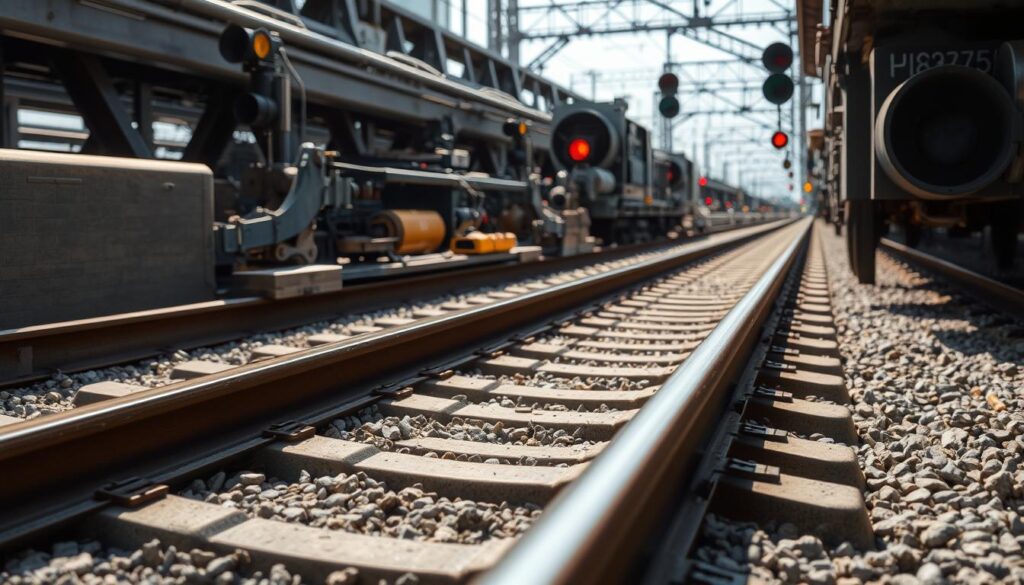
Signaling Systems
Signaling systems are another vital component, responsible for controlling train movements and preventing collisions. Advanced signaling technologies, including automatic train control and European Train Control System (ETCS), enhance safety and increase the capacity of rail networks. Effective signaling is integral to railway maintenance, as it ensures that trains operate within safe parameters.
Bridges and Tunnels
Bridges and tunnels are critical infrastructure elements that allow railways to traverse challenging terrains. The construction and maintenance of these structures require specialized engineering expertise. Bridge construction, for instance, involves complex design considerations to ensure stability and durability. Similarly, tunnel construction must account for geological conditions to prevent structural issues.
Maintenance Facilities
Maintenance facilities are essential for the upkeep of rolling stock and infrastructure. These facilities enable railway operators to perform routine inspections, repairs, and upgrades. The integration of advanced technologies, such as AI and predictive analytics, into rail construction and maintenance practices is revolutionizing the way railways are managed, enhancing both efficiency and safety.
In conclusion, the key components of rail infrastructure are interlinked, each playing a significant role in the overall performance of the rail network. Understanding and maintaining these components is crucial for the continued operation and development of efficient rail systems.
Innovations Transforming Rail Engineering
The future of rail infrastructure is being shaped by advancements in smart technologies, sustainability, and automation. These innovations are not only enhancing the efficiency and safety of rail systems but also transforming the way railway engineering is approached.
Smart Technologies in Rail Systems
Smart technologies are revolutionizing rail engineering by introducing advanced data analytics, Internet of Things (IoT) devices, and artificial intelligence (AI). These technologies enable real-time monitoring and predictive maintenance, reducing downtime and improving passenger experience.
For instance, AI-powered predictive maintenance can detect potential issues before they become critical, allowing for proactive maintenance scheduling. This not only reduces costs but also enhances safety.
Sustainable Rail Solutions
Sustainability is becoming a key focus in rail engineering, with efforts to reduce carbon footprint and promote eco-friendly practices. This includes the adoption of renewable energy sources, energy-efficient trains, and green building practices for rail infrastructure.
A notable example is the use of solar panels to power rail stations and trains, significantly reducing reliance on fossil fuels.
Automation in Rail Infrastructure
Automation is transforming rail infrastructure through the introduction of automated systems for maintenance, signaling, and even train operation. Automated systems can improve efficiency, reduce labor costs, and enhance safety by minimizing human error.
| Innovation | Description | Benefits |
|---|---|---|
| Smart Technologies | Advanced data analytics, IoT devices, AI | Real-time monitoring, predictive maintenance |
| Sustainable Solutions | Renewable energy, energy-efficient trains | Reduced carbon footprint, eco-friendly practices |
| Automation | Automated maintenance, signaling, train operation | Improved efficiency, reduced labor costs, enhanced safety |
Challenges Facing Rail Infrastructure
The aging rail infrastructure poses substantial challenges for engineers and policymakers alike. As the backbone of the transportation infrastructure, rail systems require continuous maintenance and upgrades to ensure safe and efficient operation.
Aging Infrastructure Issues
A significant challenge facing rail infrastructure is the issue of aging infrastructure. Many rail systems in the United States were constructed decades ago, and since then, traffic volume and weight have increased significantly, putting additional stress on the infrastructure.
Aging infrastructure leads to several problems, including:
- Increased maintenance costs due to wear and tear
- Reduced safety as outdated components fail
- Decreased efficiency as older systems cannot handle modern demands
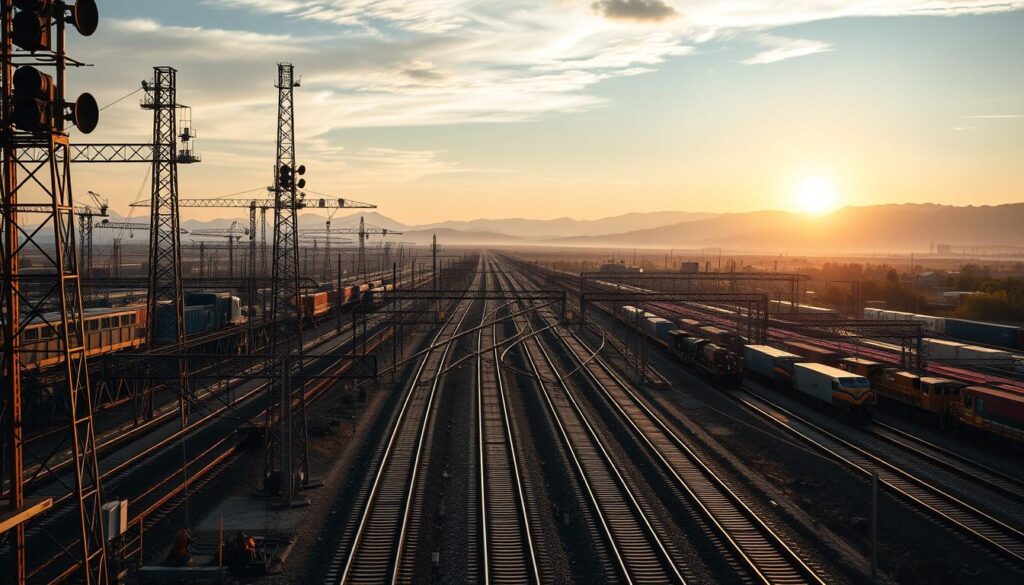
Funding and Budget Constraints
Another major challenge is funding and budget constraints. Rail infrastructure projects are capital-intensive and often require significant investment from both public and private sectors.
| Funding Source | Typical Allocation | Challenges |
|---|---|---|
| Public Funding | Grants, Bonds | Budget constraints, Political factors |
| Private Investment | PPP Models, Investors | Return on Investment, Risk Assessment |
Environmental Concerns
Environmental concerns also play a crucial role in the challenges facing rail infrastructure. As concern for climate change and environmental sustainability grows, rail infrastructure must be designed and operated to minimize its ecological footprint.
Strategies to address environmental concerns include:
- Implementing energy-efficient technologies
- Using sustainable materials in construction
- Enhancing recycling practices for rail components
By understanding these challenges and implementing effective strategies, it is possible to revitalize and enhance rail infrastructure, ensuring it remains a vital part of the transportation infrastructure.
The Role of Civil Engineers in Rail Projects
Civil engineers play a pivotal role in the development and implementation of rail projects, ensuring they are safe, efficient, and compliant with regulations. Their expertise is crucial in designing rail infrastructure that meets the demands of modern transportation systems.
Designing Safe and Efficient Railways
The design phase of rail projects is critical, as it lays the foundation for the entire infrastructure. Civil engineers use advanced software and techniques to create detailed designs that optimize the performance and safety of railways. For instance, they consider factors like terrain, environmental impact, and future expansion needs.
Key considerations in rail design include:
- Alignment and gradient optimization
- Station and track design
- Signaling and communication systems
- Drainage and erosion control measures
Collaborating with Local Governments
Effective collaboration with local governments is essential for the success of rail projects. Civil engineers work closely with government agencies to ensure that projects comply with local regulations and meet community needs. This collaboration involves regular communication, public consultations, and adjustments to project plans as necessary.
For more information on the role of civil engineers in rail projects, visit World Civil Society.
Ensuring Regulatory Compliance
Regulatory compliance is a critical aspect of rail project management. Civil engineers must ensure that all aspects of the project adhere to relevant laws, standards, and guidelines. This includes obtaining necessary permits, conducting environmental impact assessments, and implementing safety protocols.
| Regulatory Aspect | Description | Responsibility |
|---|---|---|
| Environmental Impact Assessment | Assessing the potential environmental effects of the project | Civil Engineers, Environmental Consultants |
| Safety Protocols | Implementing measures to ensure the safety of workers and the public | Civil Engineers, Safety Officers |
| Permitting | Obtaining necessary permits and approvals from regulatory bodies | Project Managers, Civil Engineers |
By focusing on these critical areas, civil engineers play a vital role in the successful delivery of rail projects, ensuring they are safe, efficient, and compliant with regulatory requirements.
Case Studies of Successful Rail Projects
Through the application of cutting-edge technologies, many rail projects have achieved remarkable success, setting new standards in transportation infrastructure. These projects not only enhance the efficiency and safety of rail travel but also demonstrate the potential for innovation in rail construction and railway maintenance.
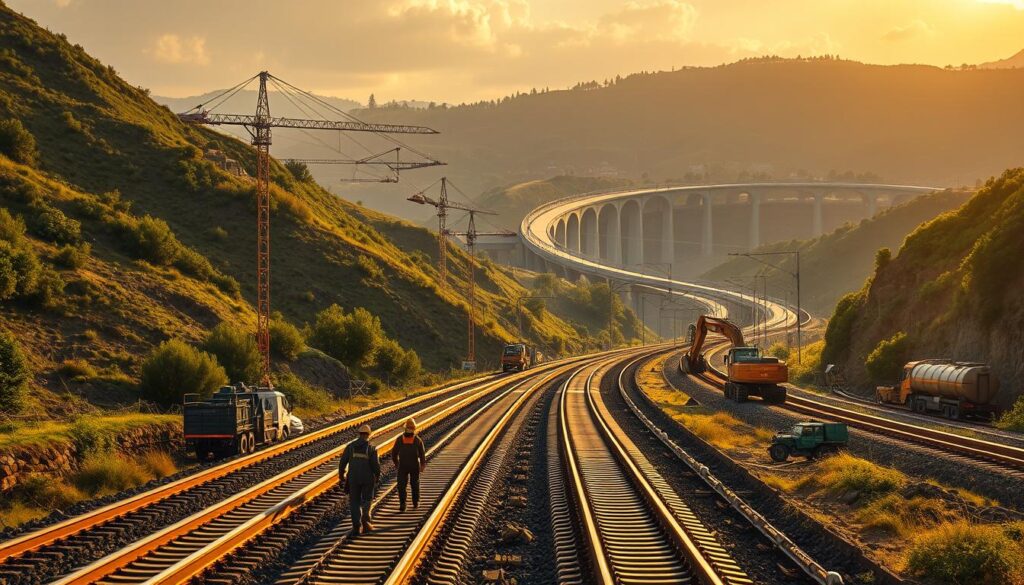
High-Speed Rail Initiatives
High-speed rail projects have revolutionized land travel, significantly reducing journey times between major cities. For instance, the introduction of high-speed rail in Japan and Europe has set a new benchmark for rail travel, combining speed with comfort and efficiency.
The use of advanced materials and technologies, such as advanced signaling systems and aerodynamic train designs, has been crucial in achieving these high speeds. Moreover, the integration of sustainable practices in the construction and operation of these rail lines has minimized environmental impact.
Urban Light Rail Systems
Urban light rail systems have become a vital component of city transportation networks, providing efficient and environmentally friendly travel options for urban populations. Cities like Portland and Denver in the United States have successfully implemented light rail systems, enhancing mobility and reducing congestion.
- Improved public transportation options
- Reduced traffic congestion
- Environmental benefits through reduced emissions
Freight Rail Modernization
The modernization of freight rail systems has been critical in enhancing the efficiency of goods transportation. Advances in railway maintenance and the adoption of digital technologies have improved the reliability and capacity of freight rail networks.
A notable example is the use of AI in monitoring the condition of critical infrastructure, such as the Forth Bridge in Scotland. This proactive approach to maintenance has significantly reduced downtime and improved safety.
| Project | Technology Used | Outcome |
|---|---|---|
| Forth Bridge Monitoring | AI and Sensor Technology | Improved Safety and Reduced Downtime |
| High-Speed Rail | Advanced Signaling and Aerodynamics | Enhanced Speed and Efficiency |
Future Trends in Rail Infrastructure Engineering
As we look to the future, rail infrastructure engineering is poised to undergo significant transformations. The industry is on the brink of a technological revolution that promises to enhance efficiency, safety, and sustainability.
Impact of Electrification
Electrification is a key trend in modernizing rail infrastructure. By transitioning from diesel to electric power, rail systems can significantly reduce their carbon footprint. Electrification also offers the potential for improved performance and reduced maintenance costs.
Benefits of Electrification:
- Reduced greenhouse gas emissions
- Lower operating costs
- Improved train performance
Integration of AI and Machine Learning
The integration of Artificial Intelligence (AI) and Machine Learning (ML) is set to revolutionize rail infrastructure engineering. These technologies can optimize maintenance schedules, predict potential failures, and enhance operational efficiency.
| Technology | Application | Benefit |
|---|---|---|
| AI | Predictive Maintenance | Reduced downtime |
| ML | Operational Optimization | Increased efficiency |
Resiliency Against Climate Change
As climate change continues to pose challenges, rail infrastructure must be designed and engineered to be resilient. This includes adapting to extreme weather conditions and rising sea levels.
Strategies for Climate Resilience:
- Elevating infrastructure in flood-prone areas
- Using climate-resilient materials
- Implementing advanced drainage systems
The future of rail infrastructure engineering is bright, with numerous trends and technologies set to transform the industry. By embracing electrification, AI, and climate resilience, we can create a more sustainable and efficient rail network.
Training the Next Generation of Rail Engineers
Training the next generation of rail engineers is crucial for the advancement of rail infrastructure worldwide. As the industry evolves, it demands a workforce equipped with the latest skills and knowledge.
Educational Programs and Degrees
Railway engineering requires a strong foundation in civil engineering and related fields. Universities and colleges offer specialized programs that focus on rail design, infrastructure management, and transportation systems. For instance, some institutions provide Master’s degrees in Railway Engineering, which cover advanced topics such as rail mechanics, signaling systems, and sustainable transportation.
Students can also benefit from civil engineering internships that offer hands-on experience in rail projects. These programs not only enhance technical skills but also provide insights into the industry’s best practices.
Hands-On Experience and Internships
Practical experience is invaluable in the field of railway engineering. Internships and apprenticeships allow students to work on real-world projects, applying theoretical knowledge to practical problems. The use of virtual reality (VR) in training is becoming increasingly popular, as it allows engineers to simulate complex scenarios in a controlled environment.
A notable example is a CRISI-funded project that utilizes innovative technologies to train rail technicians. Such initiatives demonstrate the industry’s commitment to embracing new methods for training the next generation.
Industry Certifications
Industry certifications play a critical role in ensuring that rail engineers meet the required standards. Certifications such as the Professional Engineer (PE) license are essential for demonstrating competence and expertise. Additionally, specialized certifications in areas like rail safety and signaling systems can further enhance an engineer’s qualifications.
| Certification | Description | Benefit |
|---|---|---|
| Professional Engineer (PE) License | Demonstrates expertise in engineering | Enhances credibility and career prospects |
| Rail Safety Certification | Focuses on safety protocols and regulations | Improves safety standards in rail operations |
| Signaling Systems Certification | Covers advanced signaling technologies | Supports efficient rail traffic management |
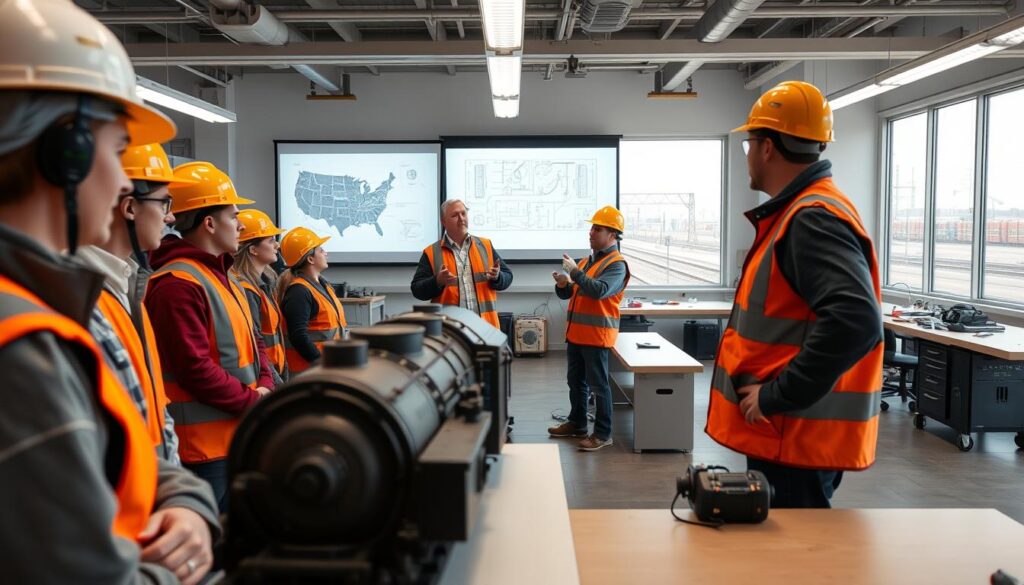
The integration of innovative technologies, such as VR, into training programs marks a significant step forward in preparing the next generation of rail engineers. By combining theoretical knowledge with practical experience and industry certifications, the rail industry can ensure a skilled workforce capable of meeting future challenges.
The Importance of Safety in Rail Engineering
Safety is paramount in rail infrastructure engineering, where the stakes involve not just the integrity of the system but also the lives of millions of passengers. Ensuring the safety of rail operations is a complex task that involves multiple facets, from the design and maintenance of tracks to the training of personnel.
Safety Protocols and Best Practices
Effective safety protocols are crucial in preventing accidents and minimizing the impact of any incidents that may occur. This includes regular maintenance of tracks and signaling systems, as well as rigorous training programs for rail staff. “Safety is not just a priority; it’s a fundamental aspect of our operations,” as emphasized by industry experts.
Best practices in railway safety also involve leveraging technology, such as advanced signaling systems and predictive maintenance tools, to enhance safety. For instance, the use of AI in predictive maintenance can help identify potential issues before they become major problems.
Impact of Safety on Public Trust
The safety record of a rail system has a direct impact on public trust and confidence in the service. A strong safety record can enhance the reputation of a rail service, encouraging more people to use it. Conversely, safety incidents can deter passengers and undermine the viability of the service.
Maintaining high safety standards is therefore not just a matter of regulatory compliance but also a key business imperative. As noted by industry leaders, “A safe rail system is a reliable and attractive option for passengers and freight customers alike.”
Emergency Response Frameworks
Despite the best efforts to prevent incidents, emergencies can still occur. Having robust emergency response frameworks in place is essential to manage such situations effectively. This includes having clear protocols for responding to incidents, trained emergency response teams, and regular drills to ensure preparedness.
For those interested in delving deeper into the world of railway engineering and its safety aspects, mastering the art of railway engineering is a valuable resource that provides insights into the latest practices and technologies.
Environmental Impact of Rail Systems
The shift towards more environmentally friendly transportation options has highlighted the importance of rail infrastructure engineering. As the world grapples with climate change and environmental degradation, the role of rail systems in reducing ecological footprint is gaining significant attention.
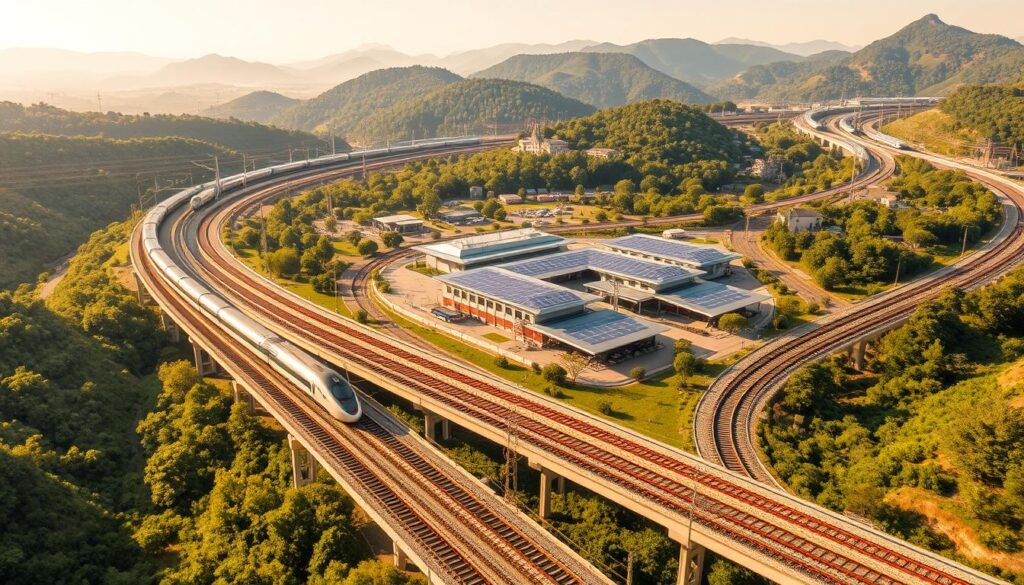
Benefits of Rail Transport Over Road
Rail transport is significantly more environmentally friendly than road transport. It produces less greenhouse gas emissions per ton-mile compared to trucks, making it a more sustainable option for freight transport. For passenger travel, rail can also reduce the number of vehicles on the road, thereby decreasing overall emissions.
- Lower emissions per passenger or ton of freight
- Energy efficiency: Rail can move a lot of freight or many passengers using relatively less energy
- Less land use: Railways can transport large volumes over long distances with less land compared to roads
Strategies for Reducing Carbon Footprint
To further minimize the environmental impact, several strategies can be employed in rail infrastructure engineering. Electrification of rail lines is a significant step, as it allows trains to run on electricity, which can be generated from renewable sources, thereby reducing dependence on fossil fuels.
- Implementing energy-efficient technologies and practices
- Using renewable energy sources for powering trains
- Optimizing rail network operations to reduce energy consumption
Green Building Practices in Rail Engineering
Green building practices are being increasingly adopted in rail infrastructure projects. This includes using sustainable materials in construction, designing stations and facilities that are energy-efficient, and incorporating green spaces into rail infrastructure.
| Practice | Benefit |
|---|---|
| Using recycled materials | Reduces waste and conserves resources |
| Energy-efficient lighting and HVAC systems | Lowers energy consumption and reduces emissions |
| Green roofs and walls | Enhances biodiversity and improves air quality |
By adopting these practices, the rail industry can significantly reduce its environmental footprint, contributing to a more sustainable future.
Financing Rail Infrastructure Projects
The financing of rail infrastructure projects involves a multifaceted approach, including public and private funding sources. Effective financing models are crucial for the development and maintenance of rail construction projects, ensuring they meet the demands of modern transportation infrastructure.
Public-Private Partnerships
One of the key strategies in financing rail infrastructure is through public-private partnerships (PPPs). PPPs allow for the collaboration between government agencies and private sector companies to fund, develop, and operate rail projects. This model not only brings in additional funding sources but also introduces private sector efficiency and innovation into public projects.
Federal and State Funding Sources
In addition to PPPs, rail construction projects often rely on federal and state funding. Government grants, subsidies, and allocations play a significant role in supporting rail infrastructure development. Understanding and accessing these funding sources is essential for project planners and stakeholders.
Budgeting for Long-Term Success
Effective budgeting is critical for the long-term success of rail infrastructure projects. This involves not only initial capital investment but also ongoing maintenance and operational costs. By prioritizing budgeting and financial planning, project managers can ensure the sustainability of transportation infrastructure over its lifespan.
In conclusion, financing rail infrastructure projects requires a comprehensive approach that leverages various funding sources and strategies. By understanding the available options and planning effectively, stakeholders can ensure the successful delivery and long-term viability of rail projects.
Stakeholder Engagement in Rail Projects
Effective stakeholder engagement is crucial for the success of rail projects, as it ensures that the needs and concerns of local communities are addressed. Engaging stakeholders fosters a collaborative environment, which is essential for the smooth execution of rail infrastructure projects.
Involving Local Communities
Involving local communities in the planning process of rail projects is vital. It helps in understanding their needs, concerns, and expectations. By doing so, project developers can identify potential issues early on and devise strategies to mitigate them. According to successful rail infrastructure projects, community engagement is a key factor in garnering public support.
Local communities can be involved through various means such as public meetings, surveys, and informational campaigns. These platforms provide opportunities for stakeholders to express their views and for project developers to communicate their plans and intentions clearly.
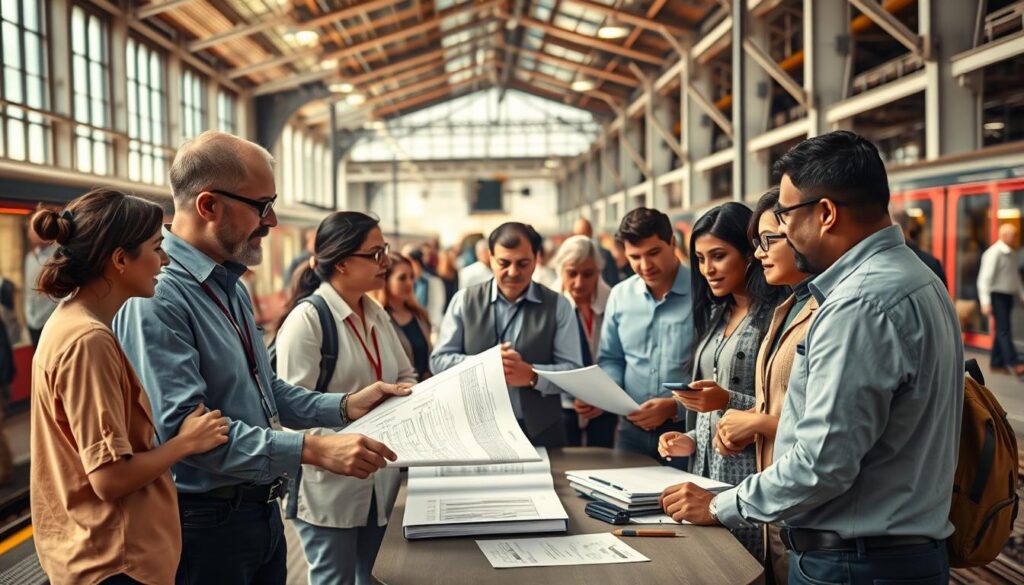
Prioritizing Public Feedback
Public feedback is a critical component of stakeholder engagement. It provides valuable insights into the concerns and preferences of the community. By prioritizing public feedback, project developers can make informed decisions that reflect the needs of the stakeholders.
Mechanisms for collecting public feedback should be transparent, accessible, and user-friendly. This can include online platforms, public hearings, and written submissions. The feedback collected should be analyzed systematically, and responses should be provided to the stakeholders, indicating how their input has been considered.
Building Consensus Among Stakeholders
Building consensus among stakeholders is essential for the successful implementation of rail projects. It involves negotiating and collaborating with various interest groups to achieve a mutually acceptable outcome. This process can be challenging but is crucial for minimizing conflicts and ensuring project continuity.
A key strategy for building consensus is to establish a stakeholder advisory group. This group can include representatives from local communities, government agencies, and other relevant stakeholders. Regular meetings and updates can help in maintaining a dialogue and fostering cooperation among the stakeholders.
| Stakeholder Group | Interests | Engagement Strategies |
|---|---|---|
| Local Communities | Noise reduction, safety, property values | Public meetings, surveys, informational campaigns |
| Government Agencies | Regulatory compliance, project timelines | Regular updates, compliance reports |
| Environmental Groups | Environmental impact, sustainability | Environmental impact assessments, green technologies |
Regulatory Framework for Rail Infrastructure
The regulatory framework governing rail infrastructure is complex and multifaceted, involving various federal and state regulations. Ensuring compliance with these regulations is crucial for the successful execution of rail projects.
Rail infrastructure engineering is subject to a myriad of laws and guidelines that dictate safety standards, environmental impact, and operational efficiency. Understanding these regulations is essential for stakeholders involved in rail infrastructure development.
Key Federal Regulations
Federal regulations play a significant role in shaping the rail infrastructure landscape. Agencies such as the Federal Railroad Administration (FRA) oversee the implementation of safety standards and operational guidelines.
Some key federal regulations include:
- 49 CFR Part 213: Track Safety Standards
- 49 CFR Part 236: Rules, Standards, and Instructions Governing the Installation, Inspection, Maintenance, and Repair of Signal Systems
- 49 CFR Part 219: Control of Alcohol and Drug Use
For more information on federal regulations, visit the FRA website.
State-Level Oversight
In addition to federal regulations, state-level oversight also plays a crucial role in rail infrastructure governance. State regulatory bodies may impose additional requirements or guidelines that rail operators must adhere to.
| State | Regulatory Body | Key Regulations |
|---|---|---|
| California | California Public Utilities Commission | General Order 143-B: Rules for the Construction and Operation of Railroads |
| New York | New York State Department of Transportation | NYCRR Part 633: Rail Safety Regulations |
Navigating Compliance Challenges
Navigating the complex regulatory landscape can be challenging for rail infrastructure stakeholders. To ensure compliance, it is essential to stay informed about regulatory updates and changes.
Best practices for compliance include:
- Regularly reviewing and updating compliance programs
- Providing ongoing training for personnel
- Engaging with regulatory bodies to clarify requirements
By understanding and adhering to the regulatory framework, rail infrastructure stakeholders can ensure the safe and efficient operation of rail systems.
Maintenance and Upkeep of Rail Infrastructure
Regular maintenance is the backbone of a reliable and efficient railway network. It ensures that rail infrastructure remains safe, functional, and capable of meeting the demands of both passenger and freight services.
Routine Inspections and Repairs
Routine inspections are a critical component of railway maintenance. These inspections help identify potential issues before they become major problems, thereby preventing accidents and reducing downtime. Regular repairs and replacements of worn-out parts are also essential to maintain the integrity of the rail system.
Key activities during routine inspections include:
- Checking for wear and tear on tracks and signals
- Inspecting bridges and tunnels for structural integrity
- Testing signaling systems to ensure they are functioning correctly
Advanced Maintenance Techniques
The use of advanced technologies has revolutionized railway maintenance. Techniques such as predictive maintenance, which utilizes data analytics and AI, enable rail operators to anticipate and address potential issues before they occur. This proactive approach reduces the likelihood of service disruptions and enhances overall safety.
Some of the advanced maintenance techniques include:
- Using drones for inspecting hard-to-reach areas like bridges and tunnels
- Implementing AI-powered predictive maintenance to forecast potential failures
- Employing advanced materials for repairs that offer longer lifespan and better durability
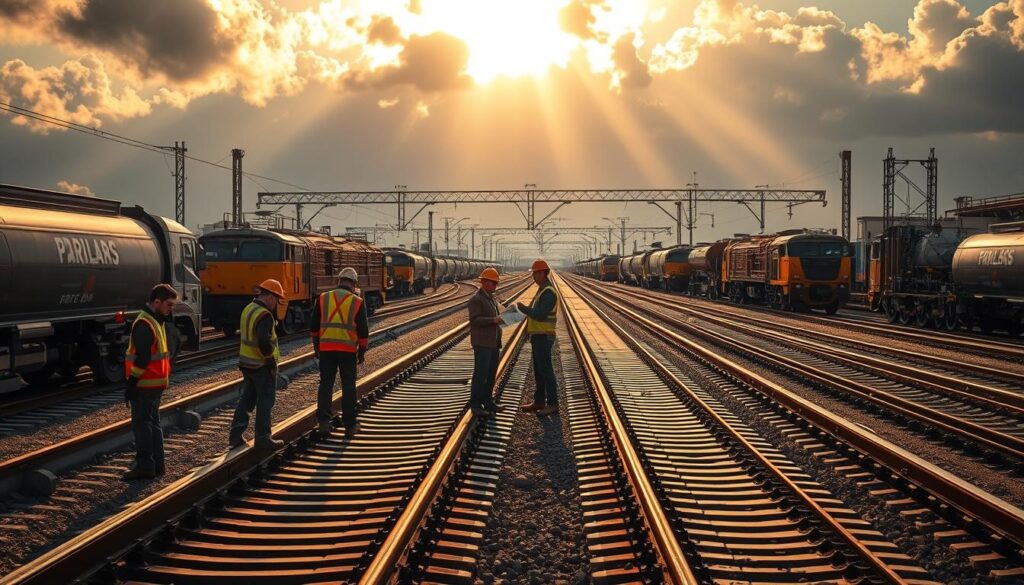
Lifespan Considerations for Rail Assets
Understanding the lifespan of rail assets is crucial for effective maintenance planning. Different components of the rail infrastructure have varying lifespans, and knowing when they are likely to need replacement or major maintenance can help in budgeting and resource allocation.
| Asset Type | Typical Lifespan | Maintenance Considerations |
|---|---|---|
| Rails | 20-30 years | Regular grinding to prevent wear |
| Signaling Systems | 15-25 years | Periodic software updates and hardware checks |
| Bridges | 50-100 years | Regular inspections for structural integrity |
By understanding these lifespans and planning accordingly, rail operators can ensure the long-term viability and efficiency of their infrastructure.
Leveraging Data and Analytics in Rail
The rail industry is on the cusp of a revolution, driven by the power of data and analytics. As rail infrastructure engineering continues to evolve, the integration of data analytics and AI is playing a pivotal role in transforming operations, maintenance, and safety.
Big Data Applications in Rail Engineering
Big data is being harnessed in various aspects of rail infrastructure engineering. From monitoring train operations to analyzing passenger traffic, big data applications are enhancing the efficiency and reliability of rail services. Predictive analytics is being used to forecast potential failures in rail infrastructure, allowing for proactive maintenance.
The use of sensors and IoT devices is generating vast amounts of data, which, when analyzed, provide insights into the condition of tracks, signals, and other critical infrastructure. This data-driven approach enables rail operators to make informed decisions, reducing downtime and improving overall system performance.
Predictive Maintenance Strategies
Predictive maintenance is revolutionizing the way rail infrastructure is maintained. By leveraging data analytics and machine learning algorithms, rail operators can predict when maintenance is required, thus preventing unexpected failures. This proactive approach not only enhances safety but also reduces maintenance costs and minimizes disruptions to service.
Condition-based maintenance is another strategy that is gaining traction. By continuously monitoring the condition of infrastructure components, maintenance activities can be scheduled based on real-time data, ensuring that resources are utilized efficiently.
Improving Efficiency Through Analytics
Data analytics is also being used to improve the operational efficiency of rail systems. By analyzing data on train movements, passenger demand, and other factors, rail operators can optimize schedules, reduce congestion, and enhance the overall passenger experience.
Furthermore, analytics is helping to identify bottlenecks and areas of inefficiency in rail networks. By addressing these issues, rail operators can improve the reliability and attractiveness of rail travel, contributing to a more sustainable transportation system.
Conclusion: The Future of Rail Infrastructure Engineering
The future of rail infrastructure engineering is poised for significant transformation, driven by innovation and collaboration. As the industry continues to evolve, it’s clear that modernisation of rail infrastructure will play a critical role in enhancing safety, performance, and sustainability.
Innovation and Collaboration
Innovation in rail infrastructure engineering is crucial for addressing the challenges posed by aging infrastructure, capacity limitations, and environmental concerns. Collaboration among stakeholders, including engineers, technicians, and safety specialists, is essential for developing and implementing effective solutions. By working together, the industry can leverage advancements in technologies like the European Train Control System (ETCS) and track monitoring sensors to improve rail safety and efficiency.
Sustainable Rail Systems
Building sustainable, efficient rail systems is vital for reducing carbon emissions and mitigating environmental impacts. The development of sustainable infrastructure will support the growing global population while ensuring a resilient transportation network. By integrating renewable energy technologies and smart city technologies, the rail industry can create a more sustainable future.
